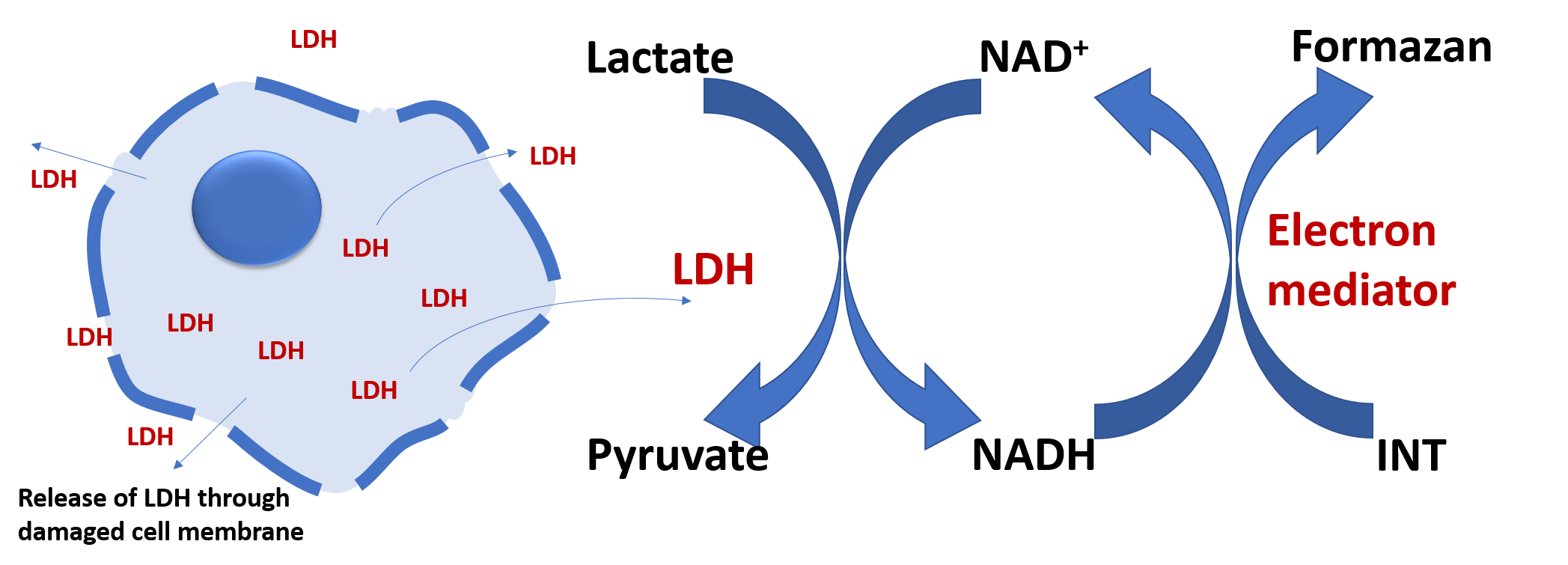LDH Cytotoxicity Assay
Measurement and monitoring of cell cytotoxicity is one of the most essential techniques in cell-based research. This technology allows for the optimization of the cytotoxic properties of anticancer compounds in toxicology testing and the toxicity of therapeutic chemicals in drug screening.
Lactate dehydrogenase (LDH) is a soluble enzyme present in the cytoplasm. When the plasma membrane is damaged, LDH is released into cell culture media. The released LDH can be detected by a couple of enzymatic reaction. First, LDH converts lactate to pyruvate by reducing NAD+ to NADH. Second, diaphorase uses NADH to reduce the tetrazolium salt (INT) to a red formazan product. The level of formazan formation is directly proportional to the amount of released LDH in the medium.
Due to the high sensitivity, non-radioactivity, and no-wash methods, LDH cytotoxicity assay is suitable for high throughput screening of cell proliferation or cytotoxicity against a variety of compounds.

Key Features
- Flexible - ideal for high-throughput screening without mixing or separation
- Convenient - formulated to have minimal hands-on time
- Non-radioactive - no special requirements for waste treatment
- Wide applications - cell proliferation and cytotoxicity
- Sensitive and accurate - as low as 300 cells can be accurately quantified
Materials
- 96-well microplates
- Microplate reader
- Substrate mix
- Assay buffer
- Stop solution
- Cell culture medium
- Cytotoxicity compound to be tested
LDH Detection Mix
- Dissolve the substrate mix with ultrapure water and mix gently.
- Thaw the assay buffer to room temperature.
- Prepare detection mix by combining assay buffer with the substrate mix and invert gently prior to use.
Recommended Controls
Set up the following controls at the same way as experimental samples.
- Non-cell control - contains growth medium without cells to serve as a negative control to determine culture medium background.
- Vehicle control - contains the same solvent used for test compounds to serve as a vehicle control.
- Negative control - contains cells but no test compounds.
- Positive control - contains cells and known proliferation or cytotoxicity inducer.
Assay Procedure
- Set up a 96-well assay plate containing 100-10,000 cells per well. Include wells without cells as negative control to determine background luminescence from LDH in the media.
- Add test compounds and vehicle-only controls to the appropriate wells and incubate for a desired period of time in a 37°C, 5% CO2 incubator.
- Add LDH detection mix prepared as described in the instruction to each well.
- Incubate for 60 minutes protected from light at room temperature.
- Add stop solution to each sample well and mix by gentle tapping.
- Record the luminescence and calculate the percentage by the following formula:
Cytotoxicity (%) = 100 x (OD sample - OD vehicle ctrl) / (OD positive ctrl - OD negative ctrl)
Notes
- Match the total volume of all the controls to 100 μL for a 96-well plate.
- The intensity and stability of the luminescent signal is temperature sensitive. For consistent results, equilibrate the reagents and samples to room temperature prior to use.
- The appropriate incubation time depends on the metabolism rate and cell concentration of the individual cell type. Optimize the incubation time for each experiment to confirm that the assay is still in the linear range.
Troubleshooting
| Problems | Possible cause | Solution |
| High medium control absorbance | High inherent LDH activity in animal sera in cell culture media | Reduce serum concentration to 1%-5% |
| High spontaneous control absorbance | High cell density | Repeat determination of optimum cell number |
| Vigorous pipetting during cell plating | Gently handle cell suspension during plate set-up | |
| Low absorbance value in experiment | Cell density was too low | Repeat determination of optimum cell number |
| High variability of absorbance well-to-well | Bubbles were in wells | Centrifuge the plate for a longer time or at a higher speed |
| Break bubbles with a syringe needle |
Cell Services:
Cell Line Testing and Assays: